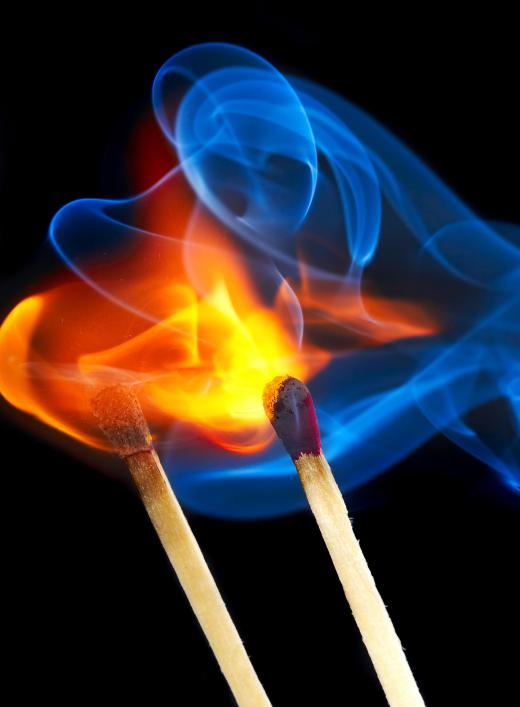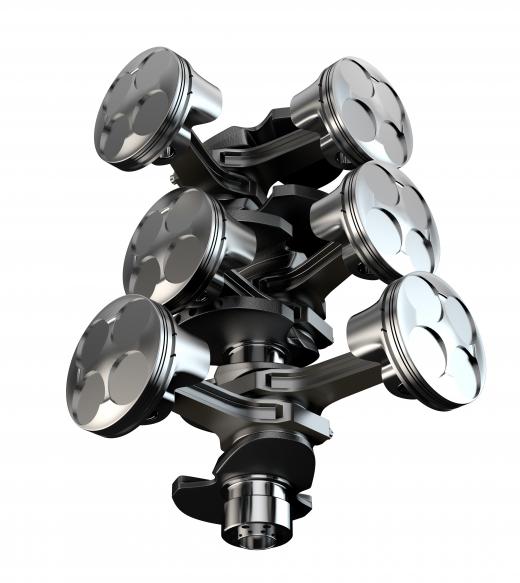What is Combustion Chemistry?
 Mary McMahon
Mary McMahon
Combustion chemistry is a branch of chemistry concerned with the study of how things burn. Technically, combustion is a chemical reaction between two or more chemicals that produces that heat and sometimes light. There are a number of interesting topics to explore within the field, and several colleges and universities have facilities dedicated specifically to this area of chemistry. Researchers who work in this field can conduct pure research, act as consultants for facilities which use combustion for various processes, and work with government agencies or private organizations that promote the advancement of chemistry.
One area of interest in combustion chemistry is which types of chemical reactions result in combustion, and what kind of conditions and chemical compounds need to present for the process to occur. Combustion efficiency is also a field of interest, exploring how efficiently certain compounds burn, and what kind of conditions could increase this efficiency. Both of these areas have real world applications, ranging from the design of car engines to the development of safety protocols for chemical labs.

Chemical reactions that produce heat are also of interest because they can be used to produce energy. The generation of energy is a continuous subject of scientific inquiry, as it has a number of far-reaching implications for the world at large. Understanding the complex mechanisms of combustion, including cascading chemical reactions, is another area of focus, with chemists attempting to learn as much as possible about chemical combustion and ways in which it could be applied.

Avoidance of inadvertent combustion is also a concern. Unstable chemicals and elements can present a safety risk if they are in environments where they are prone to catching fire. Researchers study unstable chemicals and elements to learn more about how they can be properly secured and controlled, with the goal of reducing accidents and undesirable chemical reactions that could interfere with various activities. Safety organizations may hire a combustion chemist to research and develop safety protocols for handling chemicals.

People who are interested in studying combustion chemistry will need to find an educational institution that offers training in this field. For graduate students, this includes research in lab facilities where experiments and observations can be performed, allowing students to develop and test hypothesis which they can use in the thesis they will be expected to submit as part of the process of obtaining an advanced chemistry degree.
AS FEATURED ON:
AS FEATURED ON:













Discussion Comments
@Babalaas- Complete combustion reactions only produce water and CO2, but the keyword in this situation is the word complete. There are other things in fuel that are burned besides hydrocarbons, undergoing reactions of their own. These other substances are what accounts for the other pollutants that come from your tailpipe.
Pure combustion only occurs with hydrocarbons, chains of pure carbon and hydrogen. Gasoline, diesel fuel, kerosene, and the like contain other elements like oxygen, nitrogen, sulfur, lead, mercury, and the list goes on.
These substances are ejected from the combustion engine along with the water vapor and carbon dioxide. If you were to ever look at a tailpipe in the winter, and notice it glowing, it is doing so because of the water vapor condensing in the cold air.
@Comparables- If the product of a combustion reaction is only water and carbon dioxide, why is there all this fuss about cars creating other types of greenhouse gases? In addition, why does smog and smoke come out of the back of a car if combustion only creates carbon dioxide and water?
Cars work by combustion, so they should follow the laws of chemistry...right? I do not understand how the combustion in a car would be different from the combustion in a laboratory. Someone please clarify this for me. I am a beginner with chemistry reactions and I would like to understand this better.
@MaliOhs- I am a student studying energy and I performed combustion experiments in my University level chemistry laboratory class. The experiment was to show the products of combustion. The experiment works by burning a hydrocarbon (like candle wax) and pumping the product over a piece of cobalt chloride paper and a saturated solution of lime water (calcium hydroxide).
For those that know basic chemistry, the product of a pure combustion reaction is carbon dioxide and water. The cobalt chloride paper will change color from blue to pink, indicating the presence of water vapor from the reaction.
The calcium hydroxide solution will become cloudy with particles. Essentially, the calcium hydroxide is undergoing a precipitation reaction with the carbon dioxide to form water and calcium carbonate (lime). If you were to put the calcium carbonate test tube in a centrifuge, the cloud would sink to the bottom to form a lime precipitate.
To perform a control for the test, air could be sucked through the pump, and the difference in noting how long it takes the secondary reactions to occur would indicate the reactions occurred from the combustion of the candle. Other fuels can also be used in the experiment to show the same thing. Not all combustion in chemistry is reserved for graduate students.
@mailiohs - High school and level 101 chemistry courses usually touch on combustion reactions, however you generally won't get into the more meaty studies until graduate school. As in all science courses, chemistry students build upon their knowledge and aren't let loose in the laboratory until they demonstrate a firm grasp of the scientific method, the ability to understand a chemical equation.
A simple and common combustion energy experiment for beginning students is to weigh a variety of fuels both before and after heating them to a certain temperature.
Will I be able to study and perform combustion reactions in an introduction to chemistry course or do you have to wait until you are at a more advanced level to do these kinds of experiments?
Post your comments